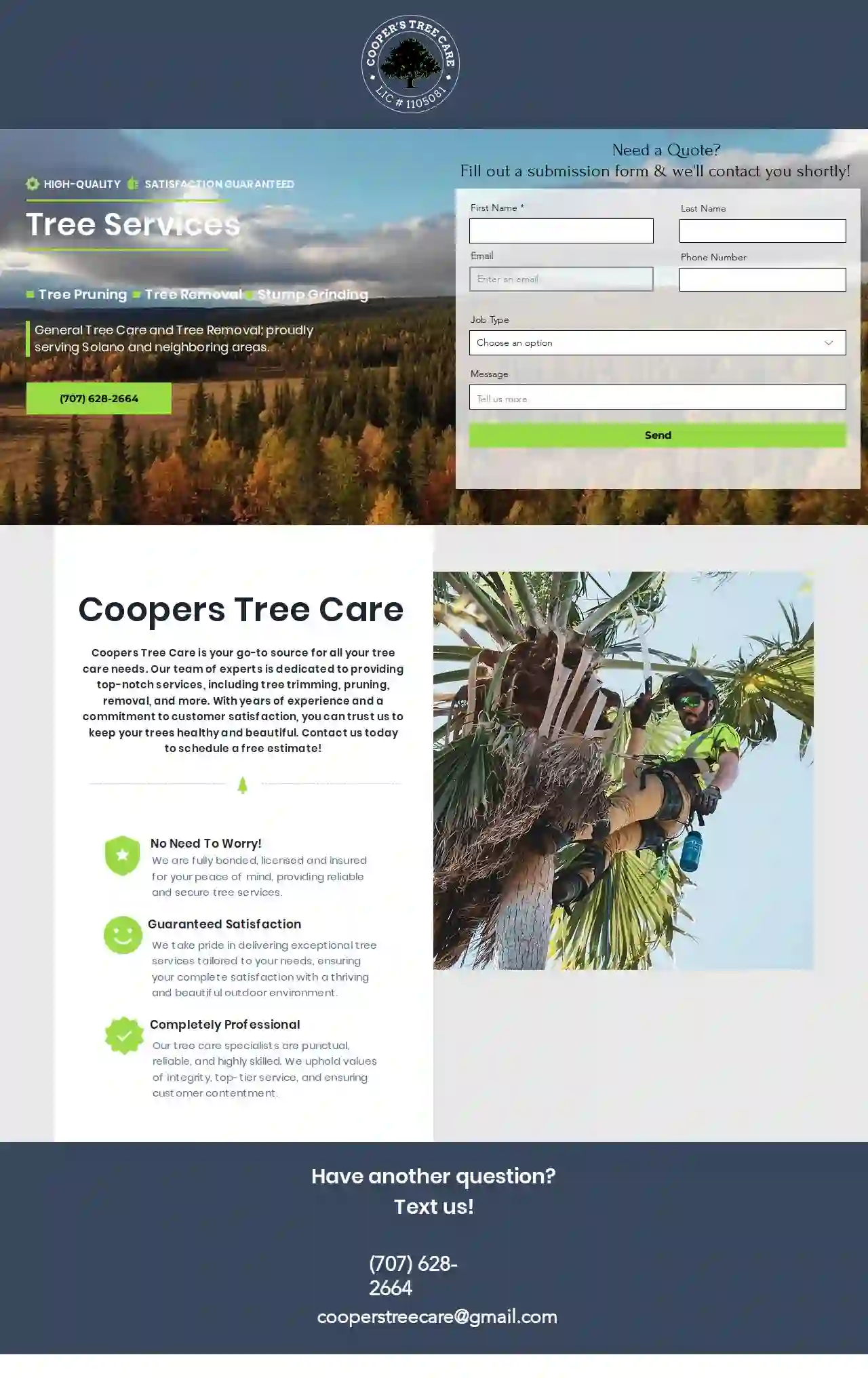Tree Trimming Vallejo
Best Tree Pruning Service in Vallejo
Get up to 3 Tree Trimming quotes for your project today! Compare profiles, reviews, accreditations, portfolio, etc... and choose the best service.
Service Needed
City or Town
- Gr
Green field tree service Corp
52 reviews123 Green St, Beverly Hills, 90210, USGreen Field Tree Service Corp is a dedicated team of arborists providing top-notch tree care services to the community. Our mission is to ensure the health and beauty of your trees while maintaining a safe environment. With years of experience, our team is equipped with the knowledge and skills to handle any tree-related task efficiently and effectively. We are fully accredited and insured, ensuring your peace of mind.
- Services
- Why Us?
- Accreditations
- Our Team
- Testimonials
- Gallery
Get Quote 
Cooper's Tree Care
530 reviewsVallejo, US- Services
- Why Us?
Get Quote
Kelly's Tree Service, Inc.
510 reviewsVallejo, US- Services
- Why Us?
Get Quote- Pa
Paradise Tree Services
514 reviewsVallejo, US- Services
- Why Us?
Get Quote
Over 1,985+ Arborists on our directory
Our tree care experts operate in Vallejo and beyond!
TreeServiceMatch has curated and vetted Top Tree Surgeons in and around Vallejo. Find the most trustworthy pro today.
Frequently Asked Questions About Tree Trimming
Find answers to common questions about tree trimming and hiring professional arborists in the USA.
- Species: Some trees require more frequent trimming than others.
- Age: Younger trees benefit from more frequent pruning to establish good structure.
- Health: Diseased trees might need more frequent attention.
- Growth rate: Faster-growing trees require more regular pruning.
- Location: Trees near structures or power lines might need more frequent trimming for safety.
- Make clean cuts: Use sharp, clean pruning tools to prevent the crushing or tearing of branches, reducing the risk of disease and decay.
- Follow the branch collar: This is the swollen area at the base of the branch. Never cut back into the branch collar, as this creates a wound that is difficult for the tree to heal.
- Remove dead, damaged, or diseased branches: This improves tree health and reduces hazards.
- Thin the crown: Selectively remove branches from within the crown to improve light penetration, air circulation, and reduce wind resistance. Thinning helps to maintain the natural shape of the tree without reducing its overall size.
- Reduce the crown: If necessary, reduce the size of the crown by shortening the branches back to strong lateral branches. This helps manage the size of the tree without damaging it.
- Avoid topping: Topping is a harmful practice that creates ugly growth and weakens trees. Never top your trees.
- Size and shape of the tree: The larger the tree, the more extensive the work will be.
- Accessibility: If the tree is difficult to reach, specialized equipment might be needed.
- Type of pruning required: Crown reduction or thinning can increase costs.
- Location: Regional differences in labor costs will affect pricing.
- Waste disposal: Removing and disposing of pruned branches adds to the expense.
- Use sharp, clean tools: Dull tools can cause tearing or crushing of the branches and increase the risk of disease.
- Wear safety gear: Protective clothing, eye protection, and gloves are crucial.
- Inspect the tree: Identify the branches that need pruning, such as dead or damaged branches.
- Use proper pruning techniques: Make clean cuts, following the branch collar. Don't remove too much of the crown in a single session.
- Dispose of the branches responsibly: Chip the debris or dispose of it according to local guidelines.
How often should I trim my trees?
Tree trimming frequency depends on several factors:
A general guideline is to have trees inspected at least every 1-2 years by a certified arborist. They can create a tailored maintenance plan that includes the appropriate pruning schedule.
A general guideline is to have trees inspected at least every 1-2 years by a certified arborist. They can create a tailored maintenance plan that includes the appropriate pruning schedule.
What is the best way to prune a tree?
Proper tree pruning techniques are essential for maintaining the health and structure of your trees. The goal is to make cuts that promote healing, maintain the natural shape, and avoid damage or weakening of the tree. Here's what to do:
For complex pruning tasks, such as crown reduction or thinning, it's strongly recommended to hire a certified arborist who has the expertise and experience to perform the work properly and safely.
For complex pruning tasks, such as crown reduction or thinning, it's strongly recommended to hire a certified arborist who has the expertise and experience to perform the work properly and safely.
How much does it cost to trim a large tree?
Trimming a large tree can be more expensive than trimming smaller trees due to the additional time and equipment required. Cost varies based on these factors:
Requesting quotes from multiple tree care companies is highly recommended for receiving competitive pricing and accurate estimates for large tree trimming projects. TreeServiceMatch will help you compare your options and make an informed choice.
Requesting quotes from multiple tree care companies is highly recommended for receiving competitive pricing and accurate estimates for large tree trimming projects. TreeServiceMatch will help you compare your options and make an informed choice.
How to prune a tree safely?
Safe tree pruning requires expertise and specialized equipment. It's highly recommended to hire a certified arborist for anything beyond minor pruning. Never attempt to prune trees that are tall, near structures, power lines, or otherwise pose a safety hazard. If you must do some minor pruning, such as cutting off small dead branches, follow these steps:
How often should I trim my trees?
Tree trimming frequency depends on several factors:
A general guideline is to have trees inspected at least every 1-2 years by a certified arborist. They can create a tailored maintenance plan that includes the appropriate pruning schedule.
- Species: Some trees require more frequent trimming than others.
- Age: Younger trees benefit from more frequent pruning to establish good structure.
- Health: Diseased trees might need more frequent attention.
- Growth rate: Faster-growing trees require more regular pruning.
- Location: Trees near structures or power lines might need more frequent trimming for safety.
A general guideline is to have trees inspected at least every 1-2 years by a certified arborist. They can create a tailored maintenance plan that includes the appropriate pruning schedule.
What is the best way to prune a tree?
Proper tree pruning techniques are essential for maintaining the health and structure of your trees. The goal is to make cuts that promote healing, maintain the natural shape, and avoid damage or weakening of the tree. Here's what to do:
For complex pruning tasks, such as crown reduction or thinning, it's strongly recommended to hire a certified arborist who has the expertise and experience to perform the work properly and safely.
- Make clean cuts: Use sharp, clean pruning tools to prevent the crushing or tearing of branches, reducing the risk of disease and decay.
- Follow the branch collar: This is the swollen area at the base of the branch. Never cut back into the branch collar, as this creates a wound that is difficult for the tree to heal.
- Remove dead, damaged, or diseased branches: This improves tree health and reduces hazards.
- Thin the crown: Selectively remove branches from within the crown to improve light penetration, air circulation, and reduce wind resistance. Thinning helps to maintain the natural shape of the tree without reducing its overall size.
- Reduce the crown: If necessary, reduce the size of the crown by shortening the branches back to strong lateral branches. This helps manage the size of the tree without damaging it.
- Avoid topping: Topping is a harmful practice that creates ugly growth and weakens trees. Never top your trees.
For complex pruning tasks, such as crown reduction or thinning, it's strongly recommended to hire a certified arborist who has the expertise and experience to perform the work properly and safely.
How much does it cost to trim a large tree?
Trimming a large tree can be more expensive than trimming smaller trees due to the additional time and equipment required. Cost varies based on these factors:
Requesting quotes from multiple tree care companies is highly recommended for receiving competitive pricing and accurate estimates for large tree trimming projects. TreeServiceMatch will help you compare your options and make an informed choice.
- Size and shape of the tree: The larger the tree, the more extensive the work will be.
- Accessibility: If the tree is difficult to reach, specialized equipment might be needed.
- Type of pruning required: Crown reduction or thinning can increase costs.
- Location: Regional differences in labor costs will affect pricing.
- Waste disposal: Removing and disposing of pruned branches adds to the expense.
Requesting quotes from multiple tree care companies is highly recommended for receiving competitive pricing and accurate estimates for large tree trimming projects. TreeServiceMatch will help you compare your options and make an informed choice.
How to prune a tree safely?
Safe tree pruning requires expertise and specialized equipment. It's highly recommended to hire a certified arborist for anything beyond minor pruning. Never attempt to prune trees that are tall, near structures, power lines, or otherwise pose a safety hazard. If you must do some minor pruning, such as cutting off small dead branches, follow these steps:
- Use sharp, clean tools: Dull tools can cause tearing or crushing of the branches and increase the risk of disease.
- Wear safety gear: Protective clothing, eye protection, and gloves are crucial.
- Inspect the tree: Identify the branches that need pruning, such as dead or damaged branches.
- Use proper pruning techniques: Make clean cuts, following the branch collar. Don't remove too much of the crown in a single session.
- Dispose of the branches responsibly: Chip the debris or dispose of it according to local guidelines.